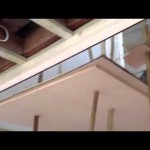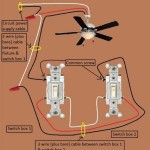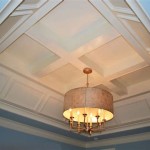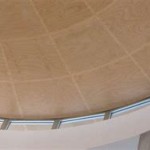Understanding The Benefits Of Copper Ceiling Tiles In Kitchen
Copper ceiling tiles are emerging as a popular choice for kitchen renovations and designs, moving beyond traditional materials like drywall or painted surfaces. This shift is driven by a combination of aesthetic appeal and functional advantages that copper offers. Understanding these benefits allows homeowners and designers to make informed decisions about incorporating copper into their kitchen spaces.
The use of copper in interior design is not entirely new. Historically, copper has been utilized in various architectural elements and decorative objects, valued for its rich color and durability. However, its application to ceiling tiles represents a more contemporary interpretation of this classic material, offering a blend of traditional charm and modern practicality.
Consideration must be given to the different types of copper ceiling tiles available. These range from solid copper tiles to tiles with a copper finish applied to a different substrate, such as steel or aluminum. The choice depends on factors like budget, desired aesthetic, and structural requirements of the ceiling. Furthermore, the installation process can vary, requiring professional expertise to ensure a secure and visually appealing outcome.
The initial cost of copper ceiling tiles may be higher than some alternative materials. However, the long-term benefits, including durability and potential increase in property value, often justify the investment. This article will explore these benefits in detail, providing a comprehensive understanding of why copper ceiling tiles are increasingly being considered a worthwhile addition to modern kitchens.
Aesthetic Appeal and Design Versatility
One of the primary advantages of copper ceiling tiles is their aesthetic appeal. Copper possesses a natural warmth and richness that can significantly enhance the visual character of a kitchen. The metallic sheen reflects light, creating a brighter and more inviting atmosphere. Unlike flat, painted ceilings, copper offers depth and visual interest, transforming a typically overlooked space into a focal point.
The design versatility of copper ceiling tiles is another key benefit. They are available in a wide array of styles, from traditional patterns to contemporary geometric designs. This allows homeowners to select tiles that complement their existing kitchen décor and reflect their personal taste. Whether the desired aesthetic is rustic, modern, or industrial, copper can be adapted to suit various design preferences.
Furthermore, copper's natural patina adds to its aesthetic charm. As copper ages, it develops a unique protective layer that changes in color over time, ranging from a bright, shiny finish to a darker, more subdued tone. This natural aging process adds character and a sense of history to the kitchen, making it a truly unique space. This patina formation can be controlled and manipulated through various treatments to achieve a specific desired look.
The reflective properties of copper should also be noted. Depending on the lighting conditions, copper ceiling tiles can cast a warm, inviting glow throughout the kitchen. This can be particularly beneficial in kitchens with limited natural light or those seeking to create a cozy and intimate ambiance. This reflectivity contributes to an overall sense of spaciousness and brightness, improving the visual appeal of the entire kitchen.
Beyond the color and reflectivity, the texture of copper ceiling tiles plays a significant role in their aesthetic impact. Embossed or hammered copper tiles create a tactile surface that adds depth and dimension to the ceiling. This texture can be further enhanced through the use of different finishes, such as brushed, polished, or antique treatments. The combination of color, reflectivity, and texture creates a visually dynamic ceiling that elevates the overall design of the kitchen.
Durability and Longevity
Durability is a significant factor contributing to the popularity of copper ceiling tiles. Copper is a naturally robust material that can withstand the rigors of a kitchen environment. It is resistant to corrosion, moisture, and heat, making it a suitable choice for a space that is often subject to spills, steam, and varying temperatures.
Unlike some other ceiling materials, copper is not prone to cracking, peeling, or warping. This ensures that the tiles maintain their structural integrity and aesthetic appearance over time. This durability translates to reduced maintenance costs and a longer lifespan compared to alternative materials like drywall or even some types of wood.
The inherent antimicrobial properties of copper also contribute to its durability and hygiene. Copper naturally inhibits the growth of bacteria, mold, and mildew, which is particularly important in a kitchen environment where food preparation occurs. This helps to create a cleaner and healthier space, reducing the risk of contamination and promoting overall hygiene.
When properly installed and maintained, copper ceiling tiles can last for decades, potentially outliving other kitchen components. This longevity makes them a cost-effective investment in the long run, as they require minimal replacement or repair. This contributes to a more sustainable approach to kitchen design, reducing waste and minimizing the need for frequent renovations.
Furthermore, copper's resistance to dents and scratches helps to maintain its aesthetic appeal even in a high-traffic area like the kitchen. While minor scratches may occur over time, they often blend in with the natural patina of the copper, adding to its character and charm. This resilience ensures that the ceiling tiles continue to look their best for many years to come, enhancing the overall value of the kitchen.
Functional Benefits and Environmental Considerations
Beyond aesthetics and durability, copper ceiling tiles offer several practical functional benefits. Copper is an excellent conductor of heat and electricity. While this is not typically a primary consideration for ceiling tiles, it can contribute to a more energy-efficient kitchen. Heat can be dissipated and distributed more evenly, reducing the need for excessive heating or cooling.
The sound-dampening properties of copper can also be beneficial in a kitchen environment. Copper can absorb sound waves, reducing noise levels and creating a more comfortable and relaxing atmosphere. This can be particularly advantageous in open-plan kitchens or those that are prone to echoing.
From an environmental perspective, copper is a highly recyclable material. At the end of its lifespan, copper ceiling tiles can be recycled and reused without losing their properties. This makes them a more sustainable choice compared to materials that end up in landfills. The recyclability of copper contributes to a circular economy, reducing the demand for virgin materials and minimizing environmental impact.
The use of recycled copper in the manufacturing of ceiling tiles further enhances their environmental benefits. Many manufacturers offer tiles made from recycled copper, reducing the energy and resources required for production. Choosing tiles made from recycled materials is a proactive way to minimize the environmental footprint of a kitchen renovation project.
The antimicrobial properties of copper, as previously mentioned, also have environmental implications. By reducing the need for harsh cleaning chemicals, copper ceiling tiles contribute to a healthier indoor environment. This can be particularly beneficial for individuals with sensitivities to chemicals or respiratory issues. The naturally hygienic properties of copper make it a more sustainable and eco-friendly choice for kitchen ceilings.
In conclusion, copper ceiling tiles offer a range of benefits that extend beyond mere aesthetic appeal. Their durability, longevity, functional properties, and environmental considerations make them a valuable addition to modern kitchens. While the initial investment may be higher than some alternative materials, the long-term advantages often justify the cost. As homeowners and designers increasingly prioritize both aesthetics and sustainability, copper ceiling tiles are poised to become an even more popular choice for kitchen renovations.

Benefits Of Using Dropped Ceiling Tiles Decorative Inc

Copper Ceiling Tiles An Overview Decorative Ceilingdecorating Com

Metal Ceiling Tiles Decorative Inc

Copper Ceiling Look Ceilings Armstrong Residential

Copper Ceiling Look Ceilings Armstrong Residential

Benefits Of Using Dropped Ceiling Tiles Decorative Inc

Copper Ceiling Look Ceilings Armstrong Residential

Copper Ceiling Look Ceilings Armstrong Residential

Copper Ceiling Look Ceilings Armstrong Residential

Benefits Of Using Dropped Ceiling Tiles Decorative Inc
Related Posts








